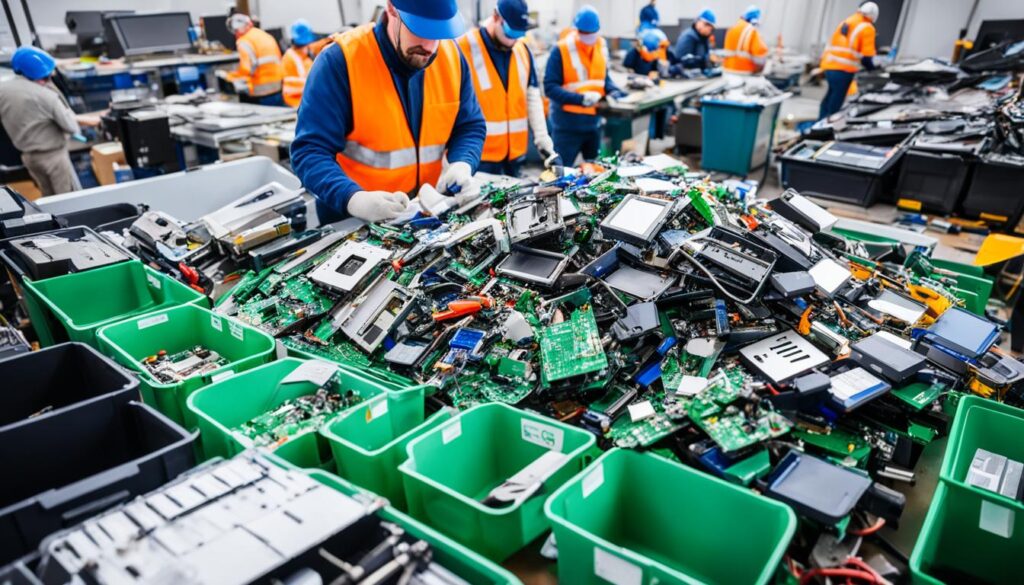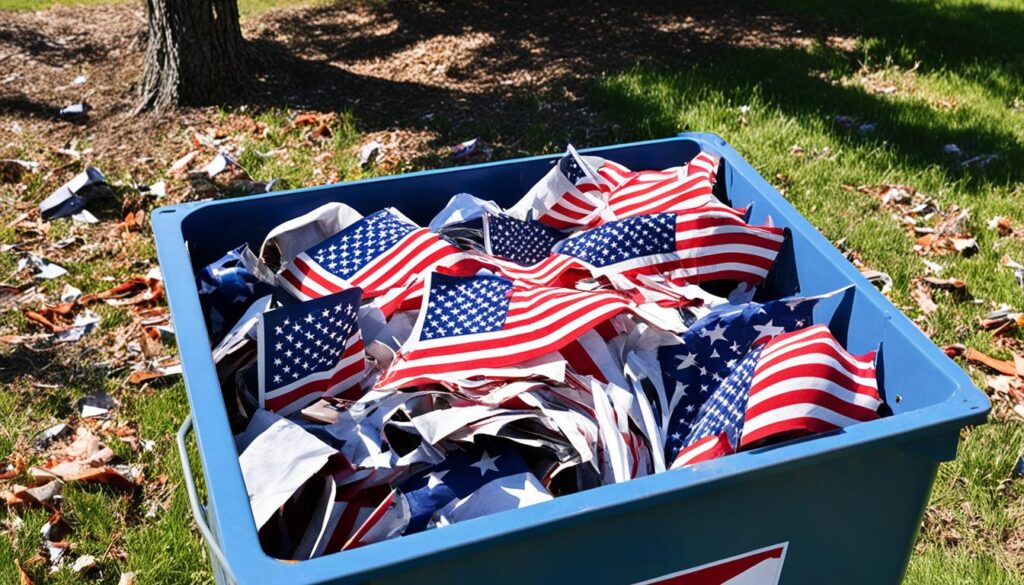As retirees transition into their well-deserved retirement, they often encounter an abundance of belongings that are no longer necessary or desirable. A crucial aspect of this new phase is disposing of these items responsibly, ensuring a streamlined and simplified lifestyle. This retiree disposal guide offers valuable insights and tips on essential items that retirees must dispose of to create a serene and organized retirement.
Key Takeaways:
- Retirees should evaluate their belongings and identify items that are no longer needed or desired.
- Proper disposal methods for essential items such as furniture, clothing, and appliances should be researched to ensure compliance with local regulations.
- Consider donating items that are in good condition but no longer needed to charitable organizations.
- Dispose of electronic waste (e-waste) responsibly by researching local e-waste recycling centers and facilities.
- Proper flag disposal should be conducted with respect and honor, following flag retirement ceremonies or alternative disposal methods.
Downsizing Checklist for Retirees
As retirees transition into a simpler and more relaxed lifestyle, downsizing becomes a crucial step in creating an organized living space. To assist retirees in this process, here is a comprehensive checklist that provides practical downsizing tips and guidance. By following these suggestions, retirees can effectively downsize their belongings, simplify their living environment, and embrace the benefits of retirement.
1. Decluttering Different Areas
Start the downsizing process by decluttering one room at a time. Begin with the areas that are less emotionally attached, such as the kitchen, living room, or spare bedrooms. Sort through your belongings and categorize them into three categories: keep, donate/sell, and discard. Embrace the mindset of minimalism and prioritize items that hold significant value or bring you joy.
2. Letting Go of Sentimental Items
Letting go of sentimental items can be challenging but necessary when downsizing. Consider taking photographs of the sentimental items and creating a digital album to preserve the memories. Alternatively, pass down cherished possessions to family members who will appreciate and treasure them. Remember, memories reside within us, not within physical objects.
3. Maximizing Storage Space
When downsizing, it’s essential to make the most of available storage space. Optimize closets, cabinets, and shelving units by using organizers and maximizing vertical space. Utilize under-bed storage containers for seldom-used items and invest in multi-functional furniture pieces, such as ottomans with hidden storage compartments.
4. Efficient Paper and Document Management
Reduce paper clutter by organizing your documents digitally. Scan important documents and store them securely on your computer or a cloud-based storage service. Shred unnecessary documents that contain sensitive information to protect your identity. Set up a filing system for physical documents, keeping only essential records and discarding outdated or trivial papers.
5. Downsizing Personal Collections
If you’re an avid collector, consider downsizing your collections while retaining a few cherished pieces. Choose items that hold the most sentimental value or have the highest monetary worth. Display the curated collection tastefully, using creative storage solutions or floating shelves to showcase your treasured items.
6. Seeking Professional Help
If the downsizing process becomes overwhelming, consider enlisting the assistance of a professional organizer or downsizing specialist. These experts can provide valuable insights, personalized solutions, and emotional support throughout the downsizing journey, making the process smoother and more efficient.
Remember, downsizing is a process, and it may take time to navigate through it successfully. By following this downsizing checklist, retirees can simplify their living spaces, reduce clutter, and fully embrace the benefits of a streamlined lifestyle in retirement.
| Benefits of Downsizing | Challenges of Downsizing |
|---|---|
| 1. Increased organization and cleanliness | 1. Letting go of sentimental items |
| 2. Reduced maintenance and cleaning responsibilities | 2. Deciding what to keep and what to discard |
| 3. Financial savings on housing costs and utilities | 3. Managing storage space efficiently |
| 4. Easier mobility and accessibility within the living space | 4. Overcoming emotional attachment to possessions |
| 5. A sense of liberation and freedom from excess belongings | 5. Ensuring smooth relocation, if applicable |
Disposing of Electronic Waste in Retirement
With the rapid advancement of technology, many retirees are faced with the challenge of disposing of outdated electronic devices. Proper disposal of electronic waste, also known as e-waste, is crucial in retirement to protect the environment and comply with local regulations. Here are important steps to follow when disposing of e-waste:
- Research local laws: Before disposing of electronic devices, retirees should research and understand the local laws and regulations regarding e-waste disposal. Different areas may have specific guidelines on how to safely dispose of various electronic items.
- Separate hazardous components: Electronic devices often contain hazardous materials such as batteries and chemicals. It is important for retirees to identify and safely separate these components before disposal. This ensures that the hazardous materials are handled and disposed of properly to minimize environmental impact.
- Contact recycling centers: To ensure proper disposal, retirees should reach out to local recycling centers that specialize in e-waste recycling. These centers have the necessary infrastructure and expertise to handle electronic devices responsibly. They can provide guidance on drop-off locations or arrange for pick-up services.
- Document the disposal process: Retirees should keep a record of the e-waste disposal process for their own reference and documentation. This can include receipts from recycling centers, certificates of destruction, or any other relevant paperwork. Documentation serves as proof that retirees have properly disposed of their electronic waste.
By following these steps, retirees can play an active role in the proper recycling and disposal of electronic waste. Not only does this help protect the environment, but it also ensures compliance with local regulations and promotes sustainability.

The Importance of Responsible E-Waste Disposal
Responsible disposal of electronic waste has significant benefits for individuals and the environment. By properly disposing of e-waste, retirees can:
“Protect the environment from hazardous materials”
Electronic devices often contain toxic substances like lead, mercury, and cadmium. When improperly disposed of, these hazardous materials can leach into the soil and water, posing a threat to ecosystems and human health. By recycling e-waste, retirees contribute to reducing pollution and preserving natural resources.
“Prevent data breaches and identity theft”
Electronic devices store personal information that can be vulnerable to data breaches and identity theft. Proper disposal ensures that sensitive data is effectively erased or destroyed, mitigating the risk of unauthorized access to personal information. Recycling centers follow secure data destruction protocols to protect retirees’ privacy and safeguard against potential security breaches.
“Promote resource conservation and sustainability”
Recycling e-waste allows for the recovery and reuse of valuable materials, such as precious metals and rare earth elements. By recycling instead of discarding electronic devices, retirees contribute to conserving natural resources, reducing energy consumption, and decreasing the demand for new raw materials.
Next, we will explore the proper methods of disposing of another important item retirees may need guidance on: the U.S. flag.
Proper Flag Disposal
Retirees who proudly display the U.S. flag at their homes may wonder about the proper way to dispose of it when it becomes old and worn out. It’s essential to handle flag disposal with the respect and honor it deserves. The following guidelines outline the etiquette of proper flag disposal.
Flag Retirement Ceremonies
Flag retirement ceremonies are significant events where retired flags are collected and burned in a dignified manner. These ceremonies provide a solemn occasion to pay tribute to the flag’s symbolism and honor its service. By participating in or organizing flag retirement ceremonies, retirees can ensure that their flags receive the appropriate retirement they deserve.
“Flag retirement ceremonies are a testament to the values and principles that the U.S. flag represents. It is a time to reflect on the sacrifices made and the freedoms we enjoy.” – [Name of Flag Ceremony Organizer]
Alternative Methods of Disposal
In addition to flag retirement ceremonies, there are alternative methods of flag disposal that retirees can consider. Burying the folded flag is a respectful way to bid farewell to the flag, symbolizing its return to the earth. This method ensures that the flag remains intact and protected.
Another option is recycling the flag. Some organizations offer flag recycling programs where retired flags are collected and properly recycled to create new flags or other patriotic items. Recycling allows the flag’s materials to be repurposed, respecting its symbolism and reducing waste.
Proper Flag Disposal Etiquette
When disposing of a flag, it is important to handle it with care and respect. Proper flag disposal etiquette includes:
- Folding the flag in the traditional manner before disposal.
- Keeping the flag clean and intact throughout the disposal process.
- Avoiding using a flag that is torn or damaged for any purpose other than disposal.
- Refraining from disposing of the flag in a way that might be disrespectful or dishonorable.
Remember, proper flag disposal honors the flag’s symbolism and ensures that it is retired with dignity.

How Can Proper Disposal of Essential Items Help with Retirement Planning in Your 40s?
Proper disposal of essential items can significantly contribute to smart retirement planning strategies in 40s. By decluttering and selling unused possessions, you can generate extra income to add to your retirement fund. Investing the profit wisely can make a significant impact on your financial stability in the long run.
Conclusion
Organizing after retirement and letting go of possessions are crucial steps for retirees to create a peaceful and simplified living environment. By following the guidelines provided in this article, retirees can declutter their homes and embrace their new lifestyle with ease. In addition to decluttering, planning your retirement strategy involves assessing your current space and determining what items truly bring joy and value to your life. This process not only helps in maintaining a tidy home but also allows retirees to focus on experiences and relationships over material possessions. Ultimately, a well-organized living environment can lead to greater peace of mind and enjoyment in one’s golden years.
Retirement brings an opportunity to reassess our belongings and prioritize what truly matters. Letting go of possessions that no longer serve a purpose allows retirees to create space for new experiences and memories. By organizing their living space, retirees can not only find a sense of calm but also make it easier to navigate daily activities.
Remember, the process of disposing of belongings in retirement is not just about getting rid of things. It’s about creating a living space that reflects the retiree’s new lifestyle and brings joy and peace. By embracing minimalism and surrounding themselves with only the essentials, retirees can optimize their living environment and enjoy a more fulfilling retirement.
FAQ
What are some essential items retirees must dispose of safely?
Retirees should consider disposing of items such as old documents, expired medications, unused kitchen appliances, outdated electronics, and excess furniture.
What are some downsizing tips for retirees?
Retirees can follow a checklist that includes decluttering different areas of the house like the bedroom, living room, kitchen, and garage. They should also prioritize sentimental items and find ways to let go of possessions that hold emotional value.
How should retirees dispose of electronic waste (e-waste)?
Retirees should research local laws regarding e-waste disposal, separate hazardous components, and contact recycling centers for proper disposal. They should also document the disposal process for record-keeping purposes.
What is the proper way to dispose of the U.S. flag as a retiree?
Retirees should participate in flag retirement ceremonies, where retired flags are collected and burned in a dignified manner. Alternatively, they can bury the folded flag or recycle it.
How can retirees organize their living space and let go of possessions?
Retirees can simplify their lives by decluttering their homes and creating a harmonious living environment. They should let go of possessions that no longer serve a purpose, reflecting their new lifestyle and bringing them joy and peace.

